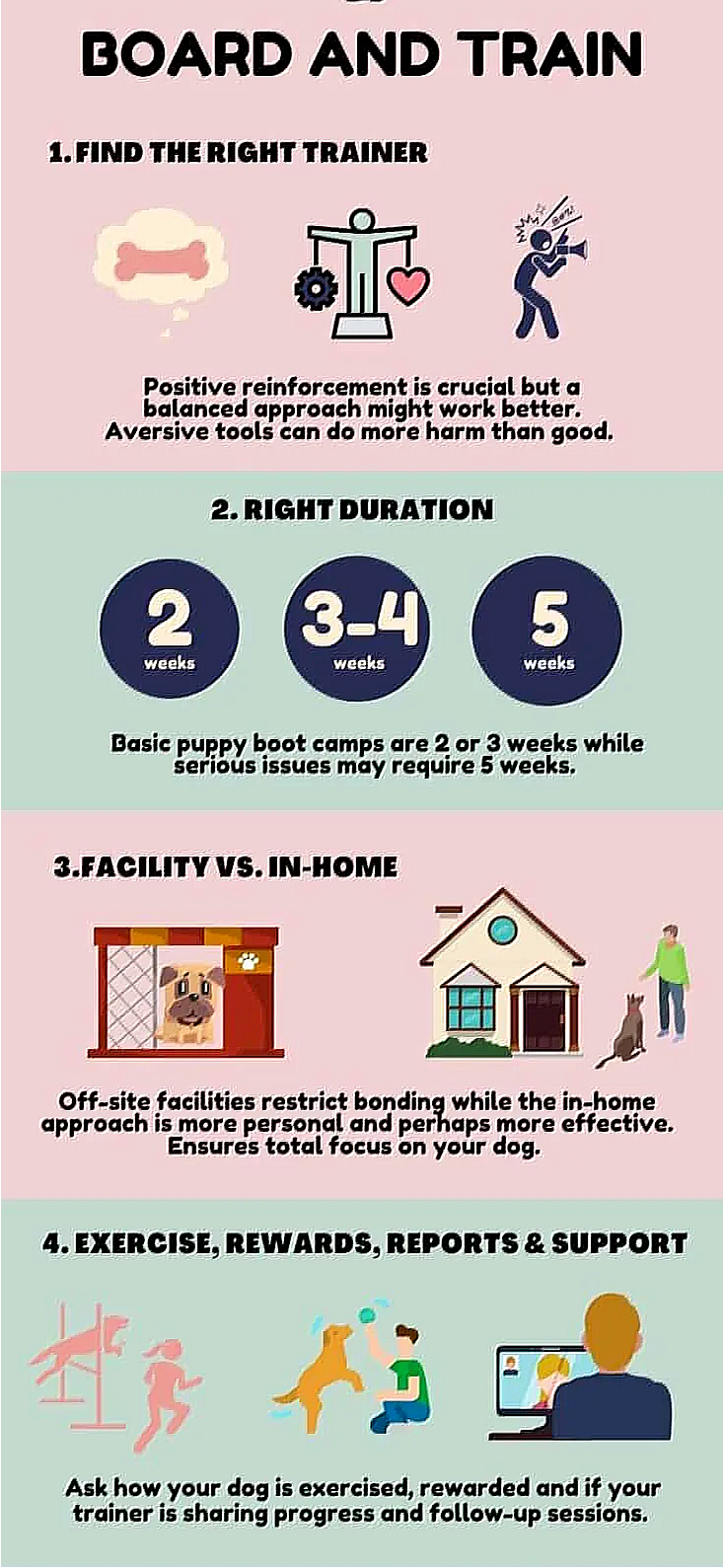BOARD AND TRAIN VS. LESSON TRAINING: FIND THE BEST FIT FOR YOUR DOG
With the rising demand for professional dog training, are pet owners better off with board and train programs or individual lesson training sessions? Many argue that board and train offers a more intensive and immersive experience, as dogs live with the trainer 24/7, creating a consistent environment for learning. Conversely, lesson training allows for gradual, hands-on progress while keeping the dog in familiar surroundings.
Board and train programs often originated from specialized trabining camps for service dogs, focusing on the dog’s development away from home distractions. According to the American Pet Association, 67% of pet owners prefer individualized lesson training for its customizable approach and regular engagement. Ultimately, selecting between these methods depends on the dog’s specific needs and the owner’s lifestyle.
Board and train programs offer immersive, round-the-clock training in a controlled environment, ideal for quick behavior modification. Lesson training provides personalized sessions with owner involvement, promoting gradual learning and strong bonds. Choosing between the two depends on the dog’s specific needs, owner’s lifestyle, and budget considerations.
Exploring Board and Train Programs: An Overview
Board and train programs allow dogs to stay with a professional trainer for a specified period, typically ranging from two weeks to a month. These programs offer an intensive, round-the-clock training experience. Trainers work on various aspects like obedience, behavior correction, and socialization. Dogs learn new commands in a distraction-free environment. This approach can lead to quicker results compared to traditional lessons.
The structure of a board and train program often includes a daily routine filled with structured activities. Trainers plan individualized sessions tailored to each dog’s needs. Such programs might incorporate playtime, feeding, and rest alongside training. This comprehensive schedule ensures dogs receive consistent guidance and supervision. Many facilities employ trained staff to assist with the care and training process.
There are several key benefits to board and train programs. Firstly, dogs receive focused attention from experienced trainers. Secondly, the immersive environment helps reinforce positive behaviors. Thirdly, owners can take a break from the challenges of training. Additionally, these programs often lead to faster progression. However, it’s important to consider the costs and the dog’s ability to adapt to new surroundings.
Despite the benefits, board and train programs have some limitations. Dogs might feel stressed in unfamiliar settings, affecting their learning. Additionally, the abrupt transition back home can lead to regression. Owners must collaborate with trainers post-program for effective long-term results. Regular follow-up sessions are usually recommended. Ensuring a smooth transition is critical for sustained success.
Definition and Structure of Board and Train
Board and train programs involve dogs living at a trainer’s facility for a dedicated period, ranging from weeks to months. During this time, the dogs undergo comprehensive training routines. This immersive approach helps establish and reinforce new behaviors in a consistent environment. The goal is to address various issues, from basic obedience to complex behavioral problems. Owners receive a well-trained pet upon completion.
The structure of board and train programs typically includes a balanced mix of activities to ensure holistic development. A daily schedule might involve multiple training sessions, socialization periods, and playtime. Trainers design personalized plans to meet each dog’s unique needs. Around-the-clock supervision ensures that dogs stay focused and safe. The collaboration between trainers and staff is vital for the program’s success.
These programs usually implement specific training modules. Examples include obedience commands, leash walking, and house manners. Trainers might also work on problem behaviors like jumping or barking. The structured approach allows for consistency and repetition. With each day, dogs build on their learning, making steady progress.
Board and train programs end with a thorough transition phase. This phase includes teaching the owners how to maintain the dog’s training. Trainers provide guidelines and tips. Follow-up sessions may be scheduled to reinforce learning. This ensures the training has a lasting impact, benefiting both the dog and the owner.
Key Benefits Offered by All-inclusive Training Programs
All-inclusive training programs offer several distinct benefits for dogs and their owners. One major advantage is the comprehensive approach to training, covering a wide range of behaviors and commands. This holistic method ensures that all aspects of a dog’s behavior are addressed. As a result, dogs often become more well-rounded and obedient. Owners report seeing significant improvements in their pets’ overall demeanor.
Another key benefit of these programs is the consistency they provide. Dogs stay with trainers and follow a structured routine, reinforcing good habits. This round-the-clock supervision helps prevent the development of bad behaviors. Consistency in training often leads to faster and more reliable results. Moreover, it ensures that the training is deeply ingrained in the dog’s daily life.
All-inclusive training programs also offer a high level of expertise. Professional trainers are equipped with the skills and knowledge necessary to address various behavioral issues. They can tailor the training to suit individual dogs’ needs and temperaments. This personalized approach maximizes the effectiveness of the training. Owners often find that professional guidance results in better long-term outcomes.
Convenience is another significant benefit for dog owners. Enrolling a dog in an all-inclusive training program means owners can delegate the training process to experts. This relieves the stress and time commitment of training the dog themselves. Additionally, trainers provide follow-up sessions and support. This ensures a smooth transition and continued progress even after the program ends.
Common Concerns and Limitations
Despite the advantages, board and train programs come with some common concerns. A significant worry for many pet owners is the high cost. These programs can be quite expensive, sometimes costing thousands of dollars. For families on a budget, this might not be a feasible option. Additionally, the cost can vary widely depending on the trainer’s expertise and the length of the program.
Another limitation is the separation anxiety that some dogs may experience. Being away from their familiar home environment can be stressful. Dogs might feel anxious, which can impact their ability to learn effectively. Some dogs adjust quickly, while others may take longer to settle in. This period of adjustment is a critical factor to consider.
There’s also the risk of inconsistent follow-through once the dog returns home. Without proper follow-up training, dogs may regress, losing the progress they made. Owners need to continue reinforcing the behaviors taught during the program. Lack of consistent effort at home can undermine the success of the training. This requires a commitment from the owners to maintain the routines set by the trainers.
Different training methods and philosophies can also be a concern. Not all board and train programs use the same techniques. Some methods may not align with an owner’s preferences or beliefs about humane training. It’s important to research and choose a program that matches the owner’s values. Transparent communication with the trainer can help mitigate this issue.
Finally, the one-size-fits-all approach might not work for every dog. While some dogs thrive in a board and train setting, others may not benefit as much. Each dog has unique needs and personalities that require tailored approaches. The generic structure of some programs may not cater to specific concerns. Evaluating the dog’s compatibility with the program is essential for success.
Unpacking Lesson Training: Personalized Approach
Lesson training offers a personalized approach, focusing on one-on-one sessions between the dog and the trainer. This method allows for customized training plans tailored to the dog’s specific needs. Each session can address particular issues, making the learning process more effective. Dogs remain in their familiar environment, which can reduce stress. This ease of adjustment often leads to better results.
A key benefit of lesson training is the active involvement of the dog owner. Owners participate in the training sessions, learning alongside their pets. This involvement fosters a stronger bond and better understanding. It also ensures owners can consistently reinforce the training. The collaborative effort contributes to long-lasting behavioral changes.
Scheduling flexibility is another advantage of lesson training. Owners can arrange sessions at convenient times. This makes it easier to fit training into busy schedules. Additionally, sessions can be adjusted in duration and frequency based on progress. Customized scheduling allows for a more relaxed pace of learning.
Lesson training is particularly effective for addressing specific behavioral issues. Trainers can focus on one problem at a time, providing in-depth solutions. This targeted approach ensures that the dog’s unique needs are met. Common issues addressed include leash pulling, jumping, and socialization challenges. Tailored strategies lead to more successful outcomes.
The cost of lesson training programs is often more affordable compared to board and train. Since the training is spread out over time, the financial burden is less intense. This affordability makes it accessible to more pet owners. It’s a cost-effective way to ensure quality training. Investing in lesson training can yield significant long-term benefits.
Overall, lesson training offers a flexible, personalized, and cost-effective approach to dog training. The active participation of dog owners and tailored solutions make it a preferred choice for many. Ongoing involvement helps maintain consistency in training. This approach is ideal for addressing specific issues and ensuring lasting behavioral improvements.
Evaluating Effectiveness: Board and Train vs. Lesson Training
When evaluating the effectiveness of board and train versus lesson training, several factors come into play. Board and train programs offer an intensive environment, leading to faster results. Dogs receive round-the-clock attention, enhancing the consistency of training. However, these programs can be costly and may involve stress for the dog. The transition back home also requires careful management.
Lesson training, on the other hand, provides flexibility and individualized attention. Owners are actively involved, making it easier to maintain consistency in training. This method allows for tailored solutions based on the dog’s specific needs. The familiar environment reduces stress, promoting better learning. Additionally, lesson training tends to be more affordable.
Comparing progress in both methods often depends on the dog’s personality and the owner’s commitment. Some dogs thrive in a board and train setting, benefiting from the immersive experience. Others may excel in lesson training due to the personalized approach and involvement of their owners. Each method has unique advantages that cater to different dogs.
| Factor | Board and Train | Lesson Training |
|---|---|---|
| Cost | Expensive | More Affordable |
| Training Environment | Consistent, Immersive | Familiar, Comfortable |
| Owner Involvement | Minimal | Active Participation |
| Stress Level for Dog | Potentially High | Lower |
Effectiveness ultimately hinges on the suitability of the program for the dog and owner. Board and train might be ideal for dogs needing significant behavior modification quickly. Lesson training works well for owners seeking involvement and gradual progress. Balancing these factors can help in choosing the best approach.
Choosing the Right Training Method for Your Dog
Selecting the best training method depends on several factors related to both the dog and the owner. One important consideration is the dog’s temperament. Some dogs thrive in immersive environments like board and train, while others perform better with personalized lesson training. Assessing your dog’s behavior can guide this decision. Consulting with a professional trainer also provides valuable insights.
Another critical factor is budget. Board and train programs tend to be more costly due to their intensive nature. If affordability is essential, lesson training might be a more viable option. It’s crucial to weigh the financial commitment against potential benefits. Ensuring that you can maintain consistency in whichever program you choose is vital for success.
- Dog’s overall health
- Learning pace of the dog
- Owner’s schedule flexibility
- Specific training needs or issues
Your lifestyle and schedule are equally important when choosing a training method. If you have limited time but need quick results, board and train might be a good fit. In contrast, owners with flexible schedules who wish to participate actively may prefer lesson training. Balancing these aspects ensures effective integration of training into daily routines.
The specific goals you have for your dog also play a role in deciding the right method. For instance, if correcting severe behavioral issues quickly is needed, board and train could be advantageous. On the other hand, for teaching basic commands or gradual improvement in behavior, lesson training works well. Deciding on clear objectives will help steer you towards the most suitable approach.
The final choice should reflect a balance between all these elements: dog’s needs, owner’s capacity, budget, and goals. Selecting an appropriate method ensures long-term success in your dog’s development and behavior management.
Real-life Success Stories of Different Training Approaches
In one case, a rescued dog named Max underwent a board and train program due to severe behavioral issues. Max was aggressive and unmanageable at home, causing his owners significant stress. After a month in the immersive program, Max showed remarkable improvement. He learned basic obedience and displayed better social behavior. His owners were thrilled with the transformation and felt more connected to their pet.
On the other hand, a Labrador Retriever named Bella benefited from lesson training. Initially, Bella was overly excited and had trouble following commands. Her owners opted for weekly lessons with a professional trainer. Over time, Bella’s behavior improved steadily. Her owners appreciated the hands-on guidance, which helped them reinforce the training at home. The gradual approach suited Bella’s learning style.
- Max: Board and Train for aggression control
- Bella: Lesson Training for gradual improvement
- Rex: Board and Train for advanced obedience
- Luna: Lesson Training for specific commands
Rex, a young German Shepherd, underwent board and train to master advanced obedience skills. His owners wanted him to be a well-disciplined service dog. During his stay, Rex learned complex commands and behaviors. The consistent and structured environment facilitated his quick learning. Post-training, Rex excelled in his new role, showcasing the program’s efficacy.
Luna, a playful Beagle, struggled with basic commands and leash manners. Her owners chose lesson training to address these issues. Weekly sessions focused on specific behaviors and allowed Luna to learn at her own pace. The personalized attention and familiar environment helped Luna succeed. Her owners maintained the progress through consistent reinforcement at home.
These success stories highlight the effectiveness of both board and train and lesson training programs. Each dog’s unique needs and circumstances determine the best approach. By selecting the right method, owners can achieve long-lasting improvements in their pets’ behavior.
Frequently Asked Questions
Choosing the right training method for your dog can be confusing. Here are some common questions and answers to help guide you through the process.
1. How long does a board and train program typically last?
Board and train programs usually last between two to four weeks. The duration depends on the dog’s specific needs and the training goals set by the owner and trainer. Some complex behavioral issues may require a longer stay.
During this period, dogs receive intensive, daily training in a controlled environment. This helps them learn and practice new behaviors consistently. Owners should follow up with additional sessions to maintain progress after the program ends.
2. Is lesson training suitable for all dog breeds and ages?
Lesson training is generally suitable for most dog breeds and ages. It allows for a personalized approach, addressing specific needs and behaviors of each dog. Puppies can start with basic commands, while older dogs might focus on correcting specific issues.
The key to success with lesson training is consistency and the owner’s involvement. By participating in the training process, owners help reinforce positive behaviors. This ensures that the dog continues to improve long after the training sessions are over.
3. Can board and train programs help with severe behavioral problems?
Yes, board and train programs are often effective for severe behavioral issues. The immersive environment provides continuous supervision and structured training. This can lead to significant improvements in a short period.
Professional trainers can address problems like aggression, anxiety, and excessive barking. However, ongoing follow-up and consistency at home are crucial for maintaining progress. Owners should be prepared to continue the training efforts after their dog returns home.
4. What are the main benefits of lesson training for dog owners?
Lesson training offers several benefits for dog owners. Firstly, it promotes active involvement, allowing owners to learn alongside their pets. This strengthens the bond between the owner and the dog.
Secondly, lesson training is flexible and can be scheduled at the owner’s convenience. It also tends to be more affordable than board and train programs. This makes it a practical option for many families.
5. How can owners maintain training results after a board and train program?
To maintain training results, owners should continue to follow the guidelines and routines set by the trainer. Regular practice and reinforcement of commands are essential. Scheduling follow-up sessions with the trainer can also help address any setbacks.
Additionally, clear communication with the trainer ensures that owners understand how to handle their dog’s behavior. Consistency at home is key to preventing regression. The more diligent the owner, the better the long-term results.
Conclusion
Choosing between board and train and lesson training depends on your dog’s unique needs and your lifestyle. Both methods offer distinct advantages that can effectively address various behavioral issues. By considering factors like cost, time, and desired outcomes, you can make an informed decision.
Ultimately, the key to successful dog training lies in consistency and dedication. Whether you opt for an immersive training program or personalized lessons, ongoing reinforcement at home is essential. With commitment and professional guidance, you can achieve lasting improvements in your dog’s behavior.







